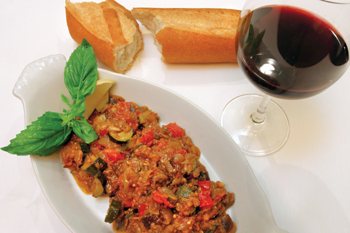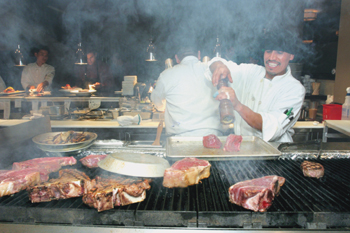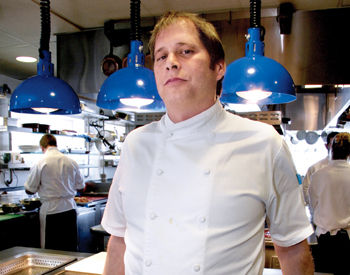![[Metroactive Dining]](/dining/gifs/dining468.gif)
[ Dining Index | Silicon Valley | Metroactive Home | Archives ]
![[line]](/gifs/line.gif)
On the Menu
Steaking Their Reputation: Hugo Ramirez (right) and the rest of chef Jeffrey Stout's crew at Alexander's work hard to help their boss maintain his reputation as a Best of Silicon Valley award winner, and that includes working with some of the more innovative ingredients Stout incorporates into the menu. Lowly Chow Goes Highbrow There's a peasant-food rebellion going on in the food world as ingredients once considered low-class are now making a big splash in fine-dining restaurants, including right here in Silicon Valley By Stett Holbrook IF THERE'S not a fancy restaurant somewhere called Peasant or Campesino, there should be. Wait a minute, I just Googled it and there is a restaurant called Peasant. It's in New York City—and believe me, while the menu is steeped in the simple, robust food of rural Italy, no peasant could afford it. Which helps illustrate my point. The lowly chow of the rural poor has gone highbrow. Peasant food, soul food, poor people's food, whatever you want to call it, is hot in fine dining. Ingredients and dishes there were once out are now haute. Restaurant criticism depends heavily on the use of evocative adjectives, and you know you're reading about one of these rootsy but expensive restaurants when you come across words like rustic, earthy, artisanal, lusty, wood-fired, simple or slow-cooked. I'd argue that the popularity of organic and natural foods and the Slow Food movement comes in part from this reverence for all things earthy, bucolic and homey. In an urbanized, synthetic culture like ours far removed from the land, these—here we go again—simple, rustic flavors are immensely satisfying. Consider some of the staples of high-end restaurants these days: heirloom tomatoes, broccoli raab, arugula (a peppery Italian green), short ribs, polenta, pork belly. Not so long ago, these ingredients were considered second-class citizens in high-end kitchens of America. Not anymore. The New Fine Dining At Napa Valley's French Laundry, arguably the most revered restaurant in America right now, one of chef Thomas Keller's signature dishes is "Tongue in Cheek," luscious braised beef cheeks paired with sliced calf's tongue, a dish made with cheap ingredients that don't usually conjure up fine dining. At one time, broccoli raab was thought of as a weed, but it now hobnobs with Belgian endive. Pork belly, a lowly cut of pork better known as a metaphor for ingratiating political influence than as dinner, has become such a fine-dining standard these days that David Kinch, chef and owner of Manresa in Los Gatos, calls it a "cliché." Even low-rent American comfort foods like meatloaf and hamburgers have been appropriated by fancy restaurants. Sure, foie gras, caviar and filet mignon are still de rigueur at white tablecloth restaurants, but what's interesting is how lowbrow foods now share the menu and sometimes the plate with more traditional "fancy" foods. What's going on here? Gastronomic slumming? What makes these humble foods so appealing to diner and chef alike? The answer may be more complex than taste alone. "The fundamental trend is a return to authenticity," says Howard Bulka, chef at Menlo Park's Marche. He sees this trend as a rebellion of sorts against the pre-packaged, homogenized, processed food that dominates so much of America. "We've gotten so distant from real foods." Bulka also believes that as people become more sophisticated and their tastes more refined, it's the simple, essential flavors and dishes they crave most. And simple tastes hark back to the earthy, slow-cooked peasant fare that connects diners to a feeling of a more genuine, perhaps idealized, bucolic past. What's Not to Like? "Where do you even start?" says Forrest Gingold, chef and co-owner of La Pastaia, when asked to describe the appeal of peasant fare. "Earthy, rustic-type cuisines are very comforting." He muses on the fact that while his restaurant occupies the boutiquey Hotel De Anza in downtown San Jose, the food is rooted in what he describes as the unpretentious, simple and hearty food made in the Italian countryside, the food of the poor. "These people had to make due with what they had—and they had more time than money," he says. Through elaborate, time-consuming preparations, Italian country cooks transformed a tough lamb shank or a pig snout into something sublime. Technique triumphed over ingredient. As a chef, Gingold says working with these kinds of foods is much more satisfying than grilling another boneless chicken breast. Using a borrowed phrase, he calls this food "the cuisine of the fifth quarter." Pigs, cows, lambs and other animals are butchered into four quarters, and from there butchers break down the animal into the familiar steaks, fillets, chops and other cuts. But that leaves out the offal—organ meats, feet, tongues, tails. The fifth quarter. These cheap cuts of meat never commanded the high price of a fillet, but to Gingold they're the true test of a chef's craft. "As long as you don't fuck it up, a tenderloin is going to taste pretty good," he says, "but it takes real skill to make the tail of an animal taste good." Gingold serves things like lamb shanks, rabbit and veal cheeks, ingredients he says he could not have offered when the restaurant opened 16 years ago. "You can tell who the foodies are because they gravitate toward these dishes," he says.
Today, diners are more adventurous, sophisticated and willing to break cultural taboos about the food they eat and that's why these low-born but sublime dishes sell, he says. Kinch, whose Los Gatos restaurant Manresa was named one of the Top 50 restaurants in the world by London's Restaurant magazine and was just named the No. 3 restaurant in the Bay Area by the Zagat guide, says the appeal of peasant fare is the powerful "memory triggers" it elicits. "It's Mama's cuisine ... and it becomes an emotional experience and creates emotional experiences for diners," he says. "I think you can say that's one of the things people pay for when dining out." One of Kinch's signature dishes is trotters, or pig's feet. For a cut of meat, it doesn't get much cheaper than that, but Kinch transforms the lowly cloven hoof into a transcendent dish by laboriously picking out the gelatinous meat and then rolling it up in the flayed skin and then frying it a delicate golden brown. It's a gloriously rich and delicious dish that didn't have me conjuring up the meals my mom cooked, but it made me a convert to pig paw nonetheless. For Kenneth Albala, chair of the University of the Pacific's history department and author of Eating Right in the Renaissance, food trends are anything but new. Foods are forever falling in and out of fashion due to a myriad of social and economic factors. He's currently writing a book about the cyclical appreciation/denigration of beans. "The question is really not so simple as foods going from peasant fare to being rediscovered by haute cuisine," he says. "Quite often when something is a status symbol, and suddenly people down the social ladder can afford it, it quickly loses its status, like spices in the course of the 16th and 17th centuries. Or conversely, when something has associations with homeland or ethnicity, it's seized upon by reverse snobs, like chile peppers and tamales for Mexicans." Movin' On Up The transformation from low chow to high chow is often propelled by perceptions of scarcity or abundance. In Europe, lobster has long been expensive and somewhat scarce and therefore upper class food. But in early America, the abundance of Maine lobster and its widespread consumption led to its status as a junk fish and poor man's food. Only after it was exported out of the area and fetched a higher price did lobster go upper class again.
Gabriella Petrick, a New York University professor of nutrition, food studies and public health, is working an article about lettuce and the vegetable's changing status in America. In the early 20th century, fresh produce was a rarity in the winter. Eating fresh lettuce carried a certain social status because of its perishability and price. But the advent of refrigerated train cars meant Salinas Valley iceberg lettuce could be shipped across the country year round. In time, iceberg lettuce's ubiquity led to its decline among trend-setting cooks. Because of its abundance, iceberg lettuce became a low-class vegetable and helped pave the way for the wave of fancy salad greens like arugula, mâche, radicchio, bib lettuce and other more rarefied (and expensive) leafy greens that were not mass-produced and were instead associated with the rural cuisines of France and Italy. In addition to the effects of scarcity and abundance, the popularity of peasant food is tied up with identity making, says Petrick. Instead of "you are what you eat" it's "you eat what you want to be." Simple, hearty and robust could be used to describe food as well as a romanticized notion of the country dwelling salt-of-the-earth folks associated with the food. "I think it's the myth that people want," she says. "It serves as a cultural emblem for a particular group of people." To a large degree, talented chefs like Jeffrey Stout, chef and co-owner of Alexander's Steakhouse in Cupertino, act as culinary ambassadors, introducing Americans to new foods and cultures that they wouldn't otherwise be willing to take a chance on. While it's changing now, the United States is unique because it makes such a distinction between "high" and "low" ingredients and considers some animal parts off-limits, says Stout. "Every culture but ours uses every part of the animal," he says. Perhaps because we're a nation of immigrants who forged new lives in a new country we have a propensity to embrace the new and reject the old, the traditional. "Or maybe we're just spoiled," says Stout. In the end, Stout wants to sell food that people want to eat, but he also wants to please himself. He sells top-shelf ingredients like foie gras, beluga caviar and $100 plates of Kobe-style beef. But as a chef, it's the simple, rustic and often time-consuming ingredients like veal tongue, trotters and pork belly that give him the most pleasure. "There's a richness and uniqueness to them," he says. In a perfect pairing of high and low, Stout serves pork belly alongside a torchon of foie gras, two luxuriously rich pieces of meat. The foie gras takes only seconds to prepare but the pork belly, which costs a fraction of the goose liver, takes about 12 hours. "For me it's a labor of love," he says. "That's what I get off on."

Help Me Help Stew: Marche chef Howard Bulka has rehabilitated the reputation of ratatouille. Poor Man's Food No More INGREDIENTS AND DISHES that were once considered out of place in upscale restaurants are now sharing the menu with haute cuisine standards like foie gras, beef tenderloin and lobster. Here are a few ingredients and dishes that have gone from lowbrow to highbrow and what some local chefs are doing with them. Oxtail: Not the meat from an actual ox, but the tail of beef cattle. Once a castoff piece of meat given away for free, oxtails now fetch a premium. The tail yields precious little meat for all the effort required to bone it out—but what rich, marrow-enriched meat it is. Oxtails have long been a staple of American soul food and thrifty cultures all over the world but have only recently been discovered by American chefs. While oxtail is usually sold in vertebrae-segmented pieces, Manresa chef David Kinch buys the entire tail. He meticulously removes the meat from the tail in one long sheet, stuffs it with marrow and then cooks it sous vide, a cutting-edge technique in which the meat is sealed in a vacuum-locked bag and simmered at a low temperature. Then the meat is chilled and seared just before serving. Cutting into the meat looks it looks like a regular oxtail, a donut of meat ringing a white bone. But instead of bone, it's marrow. "It's unbelievable," says Kinch. Beef cheeks: You won't find beef cheeks in the meat counter at your local Safeway. These meat morsels were long considered throwaway meat in this country. In Europe and in rural parts of the United States like south Texas, people who couldn't afford the tenderloin made the most of this scrap meat. Because cattle spend all day chewing, their cheeks are well-developed muscles. When braised or slow-cooked, they become uncommonly rich. At La Pastaia in San Jose, chef Forrest Gingold serves risotto with artichokes and braised veal cheeks, a sultry, deeply satisfying cold weather dish. Ratatouille: Ratatouille—braised eggplant, zucchini, bell peppers and tomatoes—is a classic of French country cooking, but you hardly see it in restaurants in part because the rustic stewy dish doesn't look great on a plate. It's home cooking. But Marche chef Howard Bulka loves it and puts it on the menu anyway alongside roasted leg of lamb. "It's almost unbelievably delicious. I think that it's so exemplary of good country French cooking." Pork belly: Like bacon? You'll love pork belly. Bacon is made from cured pork belly, a rich, fat-streaked slab of meat from the underside of a pig. It takes hours to prepare pork belly, but the result is a supremely rich, buttery piece of meat. To showcase how well pork belly stands up to more traditional fancy food fare, Alexander's Steakhouse serves pork belly paired with foie gras. The goose liver costs exponentially more than the pork belly, but you'd be hard-pressed to say which is more of an indulgence. Hamburger: The classic everyman sandwich has been reinvented as an elite meat sandwich at two Silicon Valley restaurants. Michael Mina's Arcadia restaurant serves a $16 Kobe-style beef burger. Not to be outdone, Alexander's Steakhouse serves a $20 Kobe-style beef burger topped with truffled cheese and sautéed shiitake mushrooms and truffled steak fries on the side. If that's not sybaritic enough for you, you can get seared foie gras on your burger for $40. —Stett Holbrook
Send a letter to the editor about this story to letters@metronews.com. [ Silicon Valley | Metroactive Home | Archives ]
|
From the October 26-November 1, 2005 issue of Metro, Silicon Valley's Weekly Newspaper.
Copyright © 2005 Metro Publishing Inc. Metroactive is affiliated with the Boulevards Network.
For more information about the San Jose/Silicon Valley area, visit sanjose.com.


